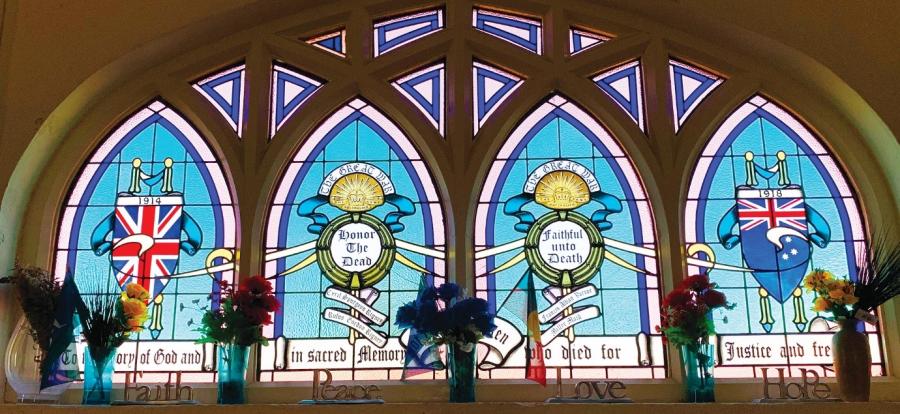The Simpson Prize 2024

The 2024 Simpson Prize Competition Question
“Commemoration of the Anzac tradition has widespread support in Australia despite different historical interpretations and debates about the nature and significance of the Anzac legend.”
To what extent does your own research support this view?
Instructions
You are encouraged to debate, agree with, or challenge the view presented in the question.
You are expected to use at least four of the sources listed below. Up to half of your response should use your own research.
Information about word or time limits, the closing date, entry forms, and judging can be found at the Simpson Prize official website.
Sources
Source 1
First Anzac Day | National Museum of Australia (nma.gov.au)
The National Museum of Australia’s webpage, First Anzac Day, outlines the history of Anzac Day and provides links to several related sources.
Source 2
Prime Minister Julia Gillard’s speech delivered at Anzac Cove, Gallipoli, Turkey on 25 April 2012
Julia Gillard: 'So this is a place hallowed by sacrifice and loss', Anzac Day - 2012 — Speakola
Source 3
Photograph of an Australian soldier, who had lost both his legs, being carried to a position to view the Anzac Day March through the streets of London, England, on 25 April 1919.
Source 4
Extract from the Australian War Memorial’s Last Post ceremony.
As Charles Bean said, ‘Many a man lying out there at Pozières or in the low scrub at Gallipoli, with his poor tired senses barely working through the fever of his brain, has thought in his last moments: “Well – well – it's over; but in Australia they will be proud of this.”’
This is the concluding statement of the Last Post Ceremony. The first Last Post Ceremony was held at the Australian War Memorial in Canberra on 17 April 2013. The ceremony occurs 364 days a year. Each ceremony tells the story behind just one of the more than 103,000 names on the Roll of Honour bronze panels that line the walls of the Commemorative Area. It will take nearly 300 years to commemorate every person on the Roll of Honour.
Source 5
Photograph of the commemorative window in the village church at Raukkan, South Australia. This window was erected by local First Nations people in 1925 to commemorate the service of Ngarrindjeri men who served in the Australian Imperial Force during the First World War.

Source 6
Statistics: Comparison of Casualties in the First World War (Casualty = captured, missing, wounded or killed). Based on Selected WW1 Statistics on the Anzac Commemorative Committee website, Selected WW1 Statistics - ANZAC Day Commemoration Committee
|
Country |
Total Casualties |
Total who Embarked for Service |
% Casualties of those who Embarked |
|
British Isles |
2,535,424 |
5,000,000 |
50.71% |
|
Canada |
210,100 |
422,405 |
49.74% |
|
Australia |
215,585 |
331,781 |
64.98% |
|
New Zealand |
58,526 |
98,950 |
59.01% |
|
India |
140,015 |
1,096,013 |
12.77% |
Source 7
Extract from historian Joan Beaumont’s Broken Nation: Australians in the Great War, 2013, pp. 551 – 554.
Permission: Allen & Unwin, 83 Alexander Street, Crows Nest NSW 2065
www.allenandunwin.com (Email sent to the company and in process)
The Anzac legend
For all its negative legacy, World War I provided a foundational narrative of Australian nationalism in the form of the Anzac ‘legend’ or ‘myth’ which, if its resilience over subsequent decades is any indication, many Australians have seen as positive. Originating in the landing at Gallipoli and rapidly gaining a hold on the Australian cultural imagination thereafter, this heroic narrative would soon be embedded in the commemorative rituals, literature and public discourse of the inter-war period. There were many agents shaping its formation and perpetuation, but none was more important than Charles Bean. The monumental official history that he edited and wrote from 1919 to 1946 articulated a powerful representation of the Australian soldier as the product of a distinctive society and value system — a society in which the bush shaped the cultural imagination and social mores; in which men learned to be independent in spirit and thus natural and resourceful fighters; in which the relative lack of class made men willing to challenge rank and authority; and in which the quality of mateship was valued above all. Little of this was empirically verifiable, but this did not matter. ‘Anzac’ was a version of the past that many — though not all — Australians wanted to hear and which, like other myths, would soon serve as a charter for the present, justifying contemporary institutions and values, keeping them in existence.63
By World War II, the Anzac myth had become hegemonic in the sense that it seemed natural even to those who were not part of the elites that created it. The army of 1939-45 took the title of the Second Australian Imperial Force, its battalions were numbered after the battalions of 1914-18, and the dead of this conflict were more often than not commemorated on the same memorials as those of World War I. Figuratively as well as physically, the men who fought World War II were the heirs to the first Anzacs. Even prisoners of the Japanese, whose surrender in 1941-42 did not fit easily into a narrative of military heroism, were able to integrate their experiences into the Anzac narrative when they came to write their memoirs in the post-war years. Forced into humiliating captivity they may have been, but they were still able to display the ‘Anzac’ qualities of mateship, humour and resourcefulness in situations of duress.64
Within two decades, however — in the 1960s and 1970s — it seemed that the dominance of the Anzac ‘legend’ was being eroded. A generation radicalized by feminism, student activism and the use of selective conscription during the Vietnam War attacked the values of Anzac and its custodian, the Returned and Services League, as militaristic, misogynist and anachronistic. As Ken Inglis later said, it seemed that ‘the ceremonies of Anzac would wither a way and its monuments become ever more archaic’. However, to its critics’ surprise, Anzac Day would rebound in the 1980s as part of a remarkable ‘memory boom’ that swept across Australia and the world. What caused this phenomenon is beyond the scope of this book, and remains a matter for ongoing debate. Suffice to say that with this ‘turning to the past’ came not only new commemorative activities — new war memorials at home and abroad, and an explosion of battlefield tours and pilgrimages, official and private — but a new affirmation of the narrative and values of Anzac in Australian public life.65
The form the Anzac legend now takes, it must be said, is somewhat different from that of earlier decades. Reflecting the values of a multicultural Australia, the language of Anzac has become more inclusive of gender and cultural diversity. It does not invoke military skills or killing, but rather courage, endurance, sacrifice and mateship — the words inscribed on the memorial unveiled at Isurava, on the Kokoda Trail, in 2002. These are not only qualities that resonate with the kinds of military operations that today’s defence personnel often conduct — what might be called ‘post-heroic’ warfare in the form of peacekeeping and humanitarian interventions. They are also, like the qualities Bean saw in the AIF, civilian values. They affirm the behaviour that a materialistic and individualistic society still requires for the purposes of social cohesion and national security. Hence the mantle of ‘the Anzac spirit’ can now be claimed by any citizens who subordinate their individual desires to needs of the collective or team — be they police, firefighters, victims of terrorism or even football players. The coach of the defeated team in the 2009 Anzac Day APL match in Melbourne, for example, claimed that his players ‘let down the Anzacs’, whereas the winning team ‘showed the true Anzac spirit’.66
The memory of World War I has therefore been demilitarized — some might say sanitised and sentimentalized — by the passage of time. Yet some things remain unchanged. The landing at Gallipoli continues to be invoked, as it was in 1915-18, as the day on which Australian nationhood was born. The men and women who volunteer to risk their lives in the service of the nation continue to be honoured as superior Australians. Beyond this, the language of Anzac continues, as it did during the conscription crises of 1916 and 1917, to be used to mobilise public support for war. In the prelude to the 2003 Iraq War, for instance, there was considerable opposition to Australia’s involvement, particularly without United Nations approval; but once the war began, this mood shifted. Thereafter, Iraq was positioned by the government and media within a lineage of wars from World War I on. The defence personnel serving in that theatre were thereby constructed as new Anzacs, entitled to honour and respect and beyond criticism. As John Howard said to personnel who had served Iraq in 2003:
You went abroad as part of a great Australian military tradition, a tradition that has never sought to oppress people, a tradition that has never sought to impose the will of this country or the collective will of a group of countries of which Australia is part, on other people and other nations, but rather a tradition that seeks to defend what is good in the world, that seeks to uphold the values for which this nation stands and seeks to deliver freedom from tyranny, from terror and oppression.67
In some ways, this statement articulates values that are not so radically different from those of Australians of 1914. Perhaps, then, the challenge of understanding the generation that fought World War I is not so daunting as it may seem. One hundred years on, the tolerance for casualties on the scale of 1914-18 has evaporated. So too have the passion for the British Empire, and the willingness to consider conscription as a policy option. However, the appeal of nationalism and the readiness on the part of the Australian population to risk the lives of those who choose to fight in the defence of core national values continue to be uncontested. So too does the belief that these values may at times have to be defended far from Australian shores, and that war — for all its human cost — is a legitimate way of doing this.
Source 8
Article: Leah Riches and James Bennett, ‘We can’t see the war for the memorials: balancing education and commemoration’, Conversation, 25 July, 2016
We can't see the war for the memorials: balancing education and commemoration (theconversation.com)
Source 9
Statistics: Number of attendees at Anzac Dawn Services, 2015-2020. Figures selected from Romain Fathi, ‘Crowds at dawn services have plummeted in recent years. It’s time to reinvent Anzac Day’, Conversation, 21 April 2021. Crowds at dawn services have plummeted in recent years. It's time to reinvent Anzac Day (theconversation.com)
|
Place |
2015 |
2016 |
2017 |
2018 |
2019 |
2020 |
2015-2019 |
|
Canberra |
120,000 |
55,000 |
38,000 |
38,000 |
35,000 |
Only officials |
-70% |
|
Melbourne |
85,000 |
45,000 |
30,000 |
35,000 |
25,000 |
Only officials |
-70% |
|
Adelaide |
20,000 |
10,000 |
5,000 |
6,000 |
5,000 |
Cancelled |
-75% |
|
Perth |
75,000 |
40,000 |
40,000 |
30,000 |
20,000 |
Cancelled |
-73% |
|
Gallipoli |
10,000 |
1,200 |
1,000 |
1,178 |
1,434 |
Cancelled |
-85% |
